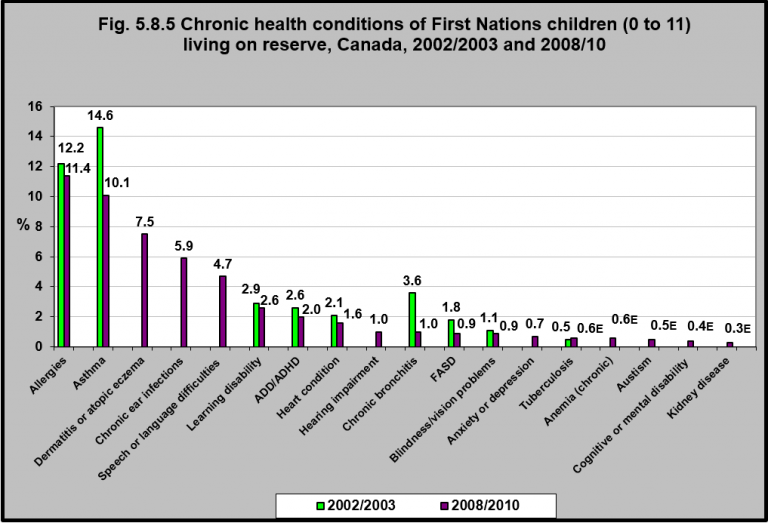Chronic health conditions of First Nations children (0 to 11) living on reserve, Canada, 2002/2003 and 2008/10

Notes:
Prevalence of hepatitis, chronic anemia, speech or language difficulties, autism, anxiety or depression, dermatitis or atopic eczema, and cancer were not assessed in RHS 2002/03.
E = high sampling variability – interpret estimate with caution.
Source: CICH graphic created using data adapted from the First Nations Regional Longitudinal Health Survey (RHS) 2008/10, National report on adults, youth and children living in First Nations Communities. https://fnigc.ca/sites/default/files/docs/first_nations_regional_health_survey_rhs_2008-10_-_national_report.pdf -accessed July 20, 2017.
In 2008/2010, one-third of First Nations children living on reserve age 0 to 11 years had been told by a health care professional that they had at least one health condition.1
Allergies and asthma were the most diagnosed chronic health conditions with both seeing a slight decrease from 2002/2003 to 2008/2010.
In 2008/2010, the average age of diagnosis for asthma was 2.3 years of age and the majority (79.2%) of First Nations children living on reserve with asthma had, at some point, taken medication (e.g. Ventalin) for their asthma. Of these First Nations children, approximately half take asthma medication at least once per week (44.3%), with 23.4% taking asthma medication at least once per day.1
In 2008/2010, dermatitis or atopic eczema was diagnosed in 7.5% of First Nations children living on reserve with the average age for diagnosis being 2.2 years of age.
In 2008/2010, 6% of First Nations children under age 12 living on reserve had been diagnosed with chronic ear infections. This number is significantly lower than data reported for Inuit children age 3 to 5 in the 2007/2008 Inuit Child Health Survey. The Inuit Child Survey reported that 37% of children had had an ear infection in the previous year with 84% receiving treatment.2
1First Nations Regional Longitudinal Health Survey (RHS) 2008/10, National report on adults, youth and children living in First Nations Communities. https://fnigc.ca/sites/default/files/docs/first_nations_regional_health_survey_rhs_2008-10_-_national_report.pdf-accessed July 12, 2017.
2The International Polar Year Nunavut Inuit Child Health Survey, 2007/2008. http://www.inuithealthsurvey.ca/pdf/Child_Inuit_Health_Survey_Aug_31.pdf-accessed August 27, 2017.
Implications
Due to the utilization of different methodologies across two rounds of the First Nations Regional Health Survey, it is not always possible to assess longitudinal trends in health status for First Nations children 0-11. While there have been improvements in a number of chronic health conditions since 2002/2003, at least 50% of First Nations children diagnosed with these conditions were undergoing some form of treatment, suggesting that some First Nations children are unable to receive treatment due to barriers to receiving health care.1 These barriers to access to health care need to continue to be addressed.
1First Nations Information Governance Centre, 2012, p. 376.
